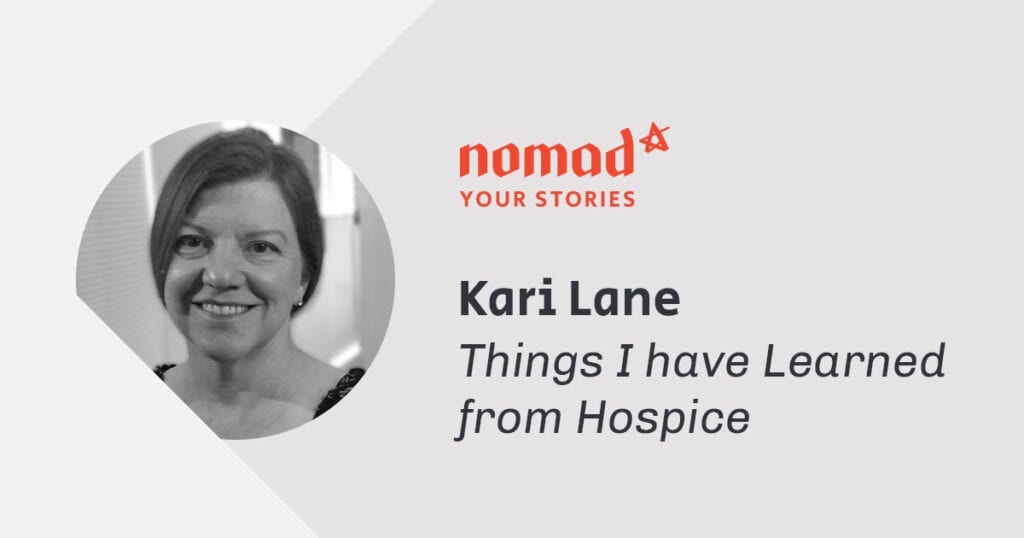I call myself a transitions nurse. I have been a nurse for many years, I worked labor and delivery for about 15 years, and worked hospice for four. So I do “comings” and “goings”. There are some very real similarities in the journeys that intrigue me. Certainly my outlook on life is affected by these experiences, which for the most part have been the experiences of others…I am involved with these huge moments in people’s lives in a very peripheral way. I like to think that I will be better at dying because of the work I have done with the dying…but I thought the same thing about birthing and I didn’t notice any significant upgrade of my aptitude in labor.

Most of my wonder at the similarities between dying and birth are more about the course of labor that the mother experiences rather than how the infant experience the same process. The physical process of labor and the physical process of dying are uniquely akin. As an observer in both circumstances – I note that the questions asked are: “Is this going to hurt?” “How long will it take?” The resolutions are: “I am tired, I am done, I cannot do this anymore.” So just as I say I am a transitions nurse; I often feel that in Hospice – I am a midwife for the dying process in the same way that I midwife’d women through the labor process.
Labor and dying are both these huge physical processes. Those of us not doing the birthing or the dying are on the sidelines, watching, trying to help but disconnected, at least physically, from the process. We cannot interfere in the process without damaging it somehow. Because each situation is unique I cannot memorize a path, or way to get through it, that is definitively helpful for everyone. Everyone labors differently and everyone dies singularly. I can help you negotiate through the rocks in the river of your dying but I cannot paddle the boat for you. I can give you the tools you will need to maneuver, but you will have to determine their worth.
However, even though we cannot do the dying and birthing for another, emotional and spiritual support affects people. Support is what I think helps the most and in the end is it all we have to offer. We support the laboring woman by giving her a safe place to labor, by relieving her pain, by teaching her what is happening. We do the same for the dying. The place of safety is often the home, where one still has at least a semblance of control; but it can be in the hospital, depending on the circumstances. It isn’t a question of morality. One can birth “the right way” in the hospital or at home; and one can die “the right way” in either place also. Having a choice, a say in the matter, is hugely important. This is one way that my work has affected more humdrum aspects of my life. I tell my family my detailed plans for my death…even I, to whom birth and death has become an everyday thing, have superstitions surrounding my death that have made me hesitant to commit a plan to writing. However, a plan is imperative. Talking to one’s family makes all the decisions easier. Remember, as difficult as it is to make these decisions for oneself; families are even more conflicted. Giving your family the gift of knowing they are following your wishes may be your last legacy of love.
This brings us to another similarity in the process of birth and death, the plan versus reality. Just as one may not always get the planned for birth experience…one may not get the dying they wanted. There are no guarantees, not in birth, life or even in death with the one exception that we get one. In other words, we get a birth, we get a life and we get a death – but that is all we can count on. Maybe in death (like life) it isn’t what happens to you that matters most, it is how you handle it, how you react. These reactions make us who we are during life and we are who we are as we die.
I always felt that women tend to labor like they get angry; some introspective and quiet, some wildly vocal. People die within their personalities. It is infrequent that families comment that their loved one’s personality had radically changed as they died. The inner spark that makes us who we are doesn’t change much. Difficult people don’t tend to get less difficult, the accommodating are inclined to remain accommodating. An awareness of this may help, not only in dealing with loved ones who are dying, but also in thinking of our own deaths.
So in being a transitions nurse, a midwife of life and death, a travel guide for the dying; what have I learned? I have learned essentially that letting go is not the same as giving up. Committing our spirit to the next adventure is not an abandonment of the current one. Like many adventures, it is often harder on those who are left behind than the voyager himself. I know how I want to die; it isn’t so much that I want to die of this rather than that, it is that I want a smile on my face and love in my heart. I want to die excited about the next step…and that really, is how I want to live also. Maybe, just maybe, by living that way – I am practicing my dying.
– Kari Lane
Leave a Reply